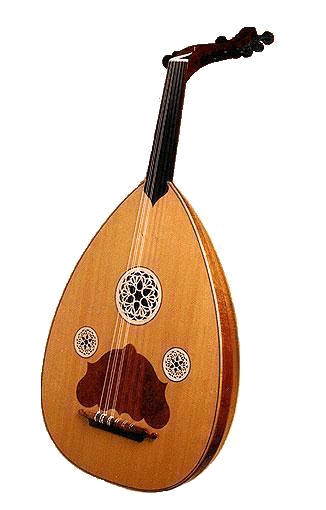Many musical instruments came into European civilisation from Islamic Civilsation. Much of this is hardly known and rarely acknowledged. This article starts to set the record straight


The Arab Contribution to Music of the Western World by Rabah Saoud
Language evidence from the names of a wide list of instruments clearly establish their Arabic-Muslim origins. Names such as lute, rebec, guitar and naker are all derived from the Arabic Al-‘ud, rabab, qitara and naqqara (table 1). Other names shawm and dulcayna were also derived from Arabic zamr and Al-zurna . Not only these instruments were themselves adopted and used but they also played a fundamental role in the evolution of European music as other “European” instruments were derived from them (table 2). The Al ‘ud (Lute) for example was used extensively in Europe before it was transformed into other musical instruments including the guitar and mandolin. The Spanish and Portuguese gaita and the English waygh and bagpipes all derived from the Arabic ghaita. The Qanun inspired the old English and Irish harps (ninth century) and derived the Austrian (German) Zither. The string musical instruments known under the Fiddle were derived from the Persian Kamancha and the Arab Rabab . European brass wind instruments like the horn and trumpet were all derived from Al-zurna. Some suggested that it was influenced by the Byzantine horn, which was brought to Europe in the tenth century; Byzantium was itself instrumentally influenced by the Muslims . The Persian Santur (dulcimer), which consists of a wooden box containing between 12 and 18 cords and two mobile rows of bridges, that the interpreter executes striking the cords to both sides of the bridges with light hammers of wood, led to the rise of the keyboard based instruments including the pantaleon (1697) and piano (18th century).
How did the Muslim instruments reach European hands? The answer to this question does not require a great deal of guessing. The visiting traders, scholars and pilgrims could easily buy such artefacts and take them home. There is also evidence that at the time of Ibn Rushd (d.1198) there was an industry, which manufactured musical instruments some of which were exported, most probably to non Muslims, via Muslim, controlled Europe . The touring singers, musicians and poetry tellers, who usually were accompanied by their instruments, visited Christian towns and villages especially in northern Spain, southern France and Italy. The Rabab, and other folk instruments, for example often used to accompany poetry recitals. Farmer acknowledged this significant role as he declared:
“Besides instruments, yet a great deal more that the instruments themselves was borrowed. The roving Arab minstrel was the chief means whereby these oriental instruments became known, and he passed on at the same time a new type of music. He may, indeed, have been the originator of the wandering minstrel class that spread all over Europe”.
The influence of Muslim music and poetry on the spread of medieval jongleurs in Spain and south France is well documented.
Table 1. Arabic Musical Instruments and their equivalent in European language.
| Instrument in transliterated Arabic Language | Instrument in European Language |
| U’d Rabab Guitara Naqqara A-Duf Al-Buq Al-Nafir Al-Shabbaba Al-Tabl Al-Tinbal Bandair Zulami |
Lute Rebec Guitar Naker Adufe Albogon Anafil Exabeba Atabal Atambal Panderete Xelami |
Table 2. Some European instruments inspired and derived from Arabic instruments.
| Arabic Musical Instruments | Instruments derived from the Arabic origin |
| Zamr Zurna GhaitaJuwaq U’d Qanun Ribab and Kamancha Santour Nay |
Shawm Dulcayna, Horn and Trumpet Gaita (Portuguese), Waygh (English), and bagpipes. Joch Guitar and Mandolin Harp and Zither Fiddle Pentaleon and Piano Flute |
For images of Muslim / Arab Musical instruments refer to Instruments Gallery (see below)
4.7 / 5. Votes 205
No votes so far! Be the first to rate this post.
Muslim Heritage:
Send us your e-mail address to be informed about our work.
This Website MuslimHeritage.com is owned by FSTC Ltd and managed by the Foundation for Science, Technology and Civilisation, UK (FSTCUK), a British charity number 1158509.
© Copyright FSTC Ltd 2002-2020. All Rights Reserved.
